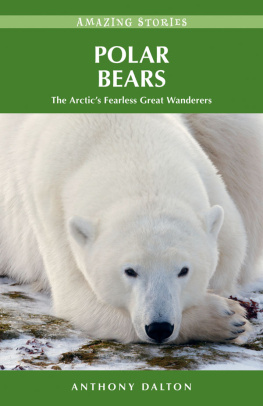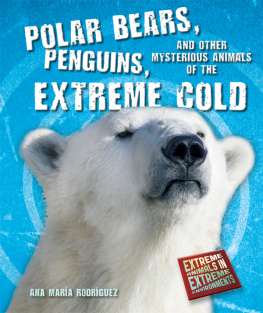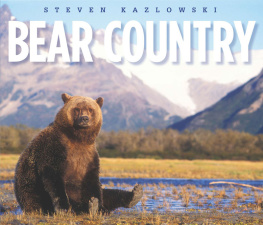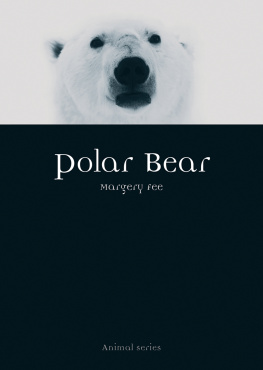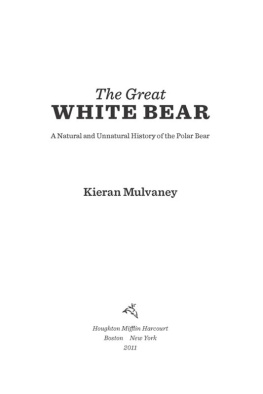
POLAR BEARS

POLAR BEARS
A Complete Guide to Their Biology and Behavior
Text by Andrew E. Derocher
Photographs by Wayne Lynch
IN ASSOCIATION WITH


2012 The Johns Hopkins University Press
All rights reserved. Published 2012
Printed in China on acid-free paper
9 8 7 6 5 4 3 2 1
The Johns Hopkins University Press
2715 North Charles Street
Baltimore, Maryland 21218-4363
www.press.jhu.edu
Library of Congress Cataloging-in-Publication Data
Derocher, Andrew E.
Polar bears : a complete guide to their biology and behavior/text by Andrew E. Derocher ; photographs by Wayne Lynch.
p. cm.
Includes bibliographical references and index.
ISBN-13: 978-1-4214-0305-2 (hardcover : alk. paper)
ISBN-10: 1-4214-0305-6 (hardcover : alk. paper)
1. Polar bear. 2. Polar bearBehavior. I. Title.
QL737.C27D47 2012
599.786dc23 2011021303
A catalog record for this book is available from the British Library.
Frontispiece: Polar bears are perfectly adapted to their Arctic world where they make their living as the top predator of the ice-covered seas. This mother has a little over two years to teach her cub the skills needed to survive in this extreme environment.
Special discounts are available for bulk purchases of this book. For more information, please contact Special Sales at 410-516-6936 or specialsales@press.jhu.edu.
The Johns Hopkins University Press uses environmentally friendly book materials, including recycled text paper that is composed of at least 30 percent post-consumer waste, whenever possible.

Fresh from a swim, this young adult female surveys her surroundings as they rapidly melt with the advancing summer. Polar bears are a threatened species because global warming in the Arctic has caused major changes in the sea ice that they depend on to hunt, travel, and mate.
Acknowledgments
Andrew E. Derocher
My interest in natural history began at an early age, fostered by catching snakes, dragonflies, and salmon fry in wild corners of Vancouver, British Columbia. I saw my first bears, black bear cubs with their mother, grazing on spring grass along the edge of a coastal rainforest while on a family outing as a child. That event sparked a lifelong interest in bears. Supporting my interest in wildlife, my parents, Edward and Shirley Derocher, encouraged me to get a university education and for this I am eternally grateful.
I would like to thank Fred Bunnell and Tony Hamilton who gave me an opportunity to study grizzly bears after finishing my undergraduate degree at the University of British Columbia. This experience set my career in motion and further fueled my interest in these wonderful animals. One rainy day in the coastal rainforest, I had the good fortune to be working with Ralph Archibald, who asked if I might be interested in studying polar bears. I thank Ralph for suggesting I contact Ian Stirling of the Canadian Wildlife Service. The following year I began a steep learning curve with Ian while completing two graduate degrees at the University of Alberta. I would like to thank Ian for his advice and direction over the years. My education in polar bear biology was aided by Dennis Andriashek, who taught me the minutiae of good planning and the importance of maintaining field gear. His mantra, one to use, one to lose, and one as a spare, saved me more than once in remote field camps.
While working at the Norwegian Polar Institute, I was fortunate to have many discussions with scientists who helped shape my understanding of Arctic ecosystems. In particular, I thank Pl Prestrud for wide-ranging discussions on the Arctic, Christian Lydersen for expanding my knowledge of seal ecology, Magnus Andersen for his solid assistance, Dag Vongraven for our discussions about polar bear management, and ystein Wiig of the University of Oslo for many wonderful field seasons in the Norwegian Arctic. I have had the good fortune of working with many talented graduate students in my lab and I would like to thank them for their contributions. Over the years I have flown with many incredible pilots. I would especially like to thank pilots Steve Miller and Mike Woodcock for their contributions to polar bear research.
Much of the information in this book was gleaned from more than 40 field expeditions and hundreds of scientific papers. Modern polar bear research now spans almost 50 years, and over those years, numerous researchers have labored, often under difficult and dangerous conditions, to obtain insights into this intriguing and complex species. This book is a tribute to the people who have worked over the years to understand polar bears.
Working with Wayne Lynch on this book has been a dream come true. Wayne and I first met more than two decades ago, early in his career as a wildlife photographer. A polar bear scientist could not have a better photographer, and the process of melding words with images has been wonderful. Stephen Hamilton kindly assisted with the production of maps. The Johns Hopkins University Press has been a delight to work with, and Vincent J. Burke, the life sciences editor, provided crucial direction. I am thankful to the managing editor, Juliana McCarthy, the copy editor, Anne R. Gibbons, the production editor, Andre Barnett, and the designer, Glen Burris, who all made significant contributions in moving this book to fruition.
Over the years, my research has been supported by a wide array of agencies. I thank ArcticNet, the Canadian Association of Zoos and Aquariums, the Canadian Wildlife Federation, the Canadian Wildlife Service, the Inuvialuit Game Council, Manitoba Conservation, Minerals Management Service of the US Department of the Interior, the Natural Sciences and Engineering Research Council of Canada, the Northwest Territories Department of Environment and Natural Resources, the Norwegian Polar Institute, Nunavut Department of Environment, Nunavut Wildlife Management Board, Parks Canada, Polar Bears International, Polar Continental Shelf Project, Quark Expeditions, and World Wildlife Fund (Canada).
More than anyone else, I thank my partner in life, Kathy Pontus. Through many years of long field seasons, Kathy encouraged and supported my passion for studying polar bears. Without her assistance, this book would not have happened. Kathy patiently reviewed many drafts of the book and made numerous important suggestions to increase its accessibility. My children, Angus and Emma, provided me with ongoing inspiration to keep working to ensure that polar bears are around for future generations.
Wayne Lynch
I saw my first polar bear in 1981. Three decades later, having traveled the globe in search of wildlife, I still find the polar bear one of the most engaging and beautiful creatures on earth. Perhaps the reason Ursus maritimus
Next page

